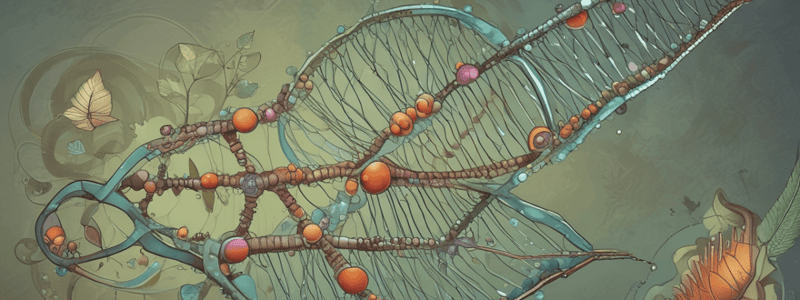Podcast
Questions and Answers
What is the main difference between linkage and independent assortment in terms of the chromosomes involved?
What is the main difference between linkage and independent assortment in terms of the chromosomes involved?
Linkage involves genes on the same chromosome, while independent assortment involves genes on different chromosomes.
What is the purpose of synapsis and crossing over in the process of gamete formation?
What is the purpose of synapsis and crossing over in the process of gamete formation?
Synapsis allows for the alignment of non-sister chromatids, and crossing over enables the exchange of DNA between homologous chromosomes, leading to the creation of new combinations of alleles.
Why are genes for different phenotypes, such as eye color, often located on the same chromosome (X) and inherited together?
Why are genes for different phenotypes, such as eye color, often located on the same chromosome (X) and inherited together?
Because these genes are linked together on the same chromosome, making it more likely for them to be inherited together.
What is the main factor that determines the likelihood of crossing over between two genes on the same chromosome?
What is the main factor that determines the likelihood of crossing over between two genes on the same chromosome?
What is the rare phenomenon that occurs when two pairs of genes on the same chromosome undergo crossing over?
What is the rare phenomenon that occurs when two pairs of genes on the same chromosome undergo crossing over?
What is the relationship between the distance between two genes and the chance of crossing over between them?
What is the relationship between the distance between two genes and the chance of crossing over between them?
What is the purpose of linkage mapping, and how does it contribute to our understanding of genetics?
What is the purpose of linkage mapping, and how does it contribute to our understanding of genetics?
What is the relationship between the frequency of crossing-over and the distance between two genes?
What is the relationship between the frequency of crossing-over and the distance between two genes?
What is the formula used to calculate the frequency of crossing-over between two genes?
What is the formula used to calculate the frequency of crossing-over between two genes?
How do you determine the frequency of double cross-over events?
How do you determine the frequency of double cross-over events?
What is interference in the context of genetic mapping?
What is interference in the context of genetic mapping?
How do you quantify interference in genetic mapping?
How do you quantify interference in genetic mapping?
What is the effect of positive interference on crossover events?
What is the effect of positive interference on crossover events?
How do you determine the genotype of offspring with multiple crossover events?
How do you determine the genotype of offspring with multiple crossover events?
What is the relationship between the distance between genes and the likelihood of multiple crossover events?
What is the relationship between the distance between genes and the likelihood of multiple crossover events?
Flashcards are hidden until you start studying
Study Notes
Linkage and Crossing Over
- Linkage changes both phenotype and genotype, and occurs when genes are on the same chromosome, forming a linkage group.
- Independent assortment only occurs when genes are on different chromosomes.
Synapsis and Crossing Over
- Synapsis: Non-sister chromatids of homologous chromosomes line up side by side.
- Crossing over: Exchange of DNA between homologous chromosomes, allowing mixing of paternal and maternal DNA to create new combinations of alleles.
Parental and Non-Parental Combinations
- Parental combinations are the most frequently observed in F2, requiring no recombination, with chromosomes directly inherited.
- Non-parental combinations arise due to crossing over of homologous X chromosomes in females, exchanging alleles and creating new combinations.
Factors Affecting Crossing Over
- Distance between genes: The bigger the distance, the more likely crossing over will occur.
- Closer genes are less likely to recombine.
- Double crossovers are very rare.
Linkage Mapping
- Helps determine the number and location of genes on chromosomes.
- Distance between two genes is directly proportional to the chance of crossing-over between them.
- Units of measurement: mu.
Constructing a Linkage Map
- Consider each pair of genes separately.
- Identify recombinants.
- Add up total recombinants and use the formula.
- Draw results on a map, using shortest distances.
Interference and Coefficient of Coincidence
- Interference: When a single crossover event affects the probability of a second crossover occurring in that vicinity.
- Can be quantified and has a positive or negative value.
- Interference is 1 - coefficient of coincidence.
Multiple Crossovers
- Multiple crossovers can occur between genes.
- 2 crossovers result in parental genes, 3 crossovers result in recombinant genes, and so on.
- The further apart genes are, the more likely they are to cross over multiple times.
Studying That Suits You
Use AI to generate personalized quizzes and flashcards to suit your learning preferences.




